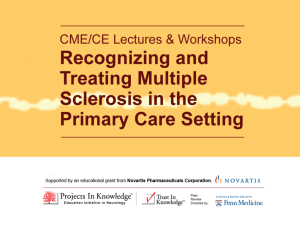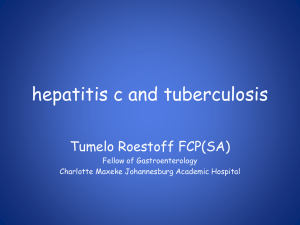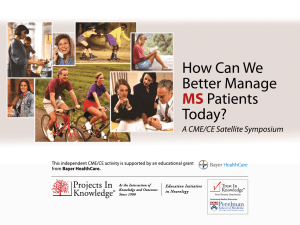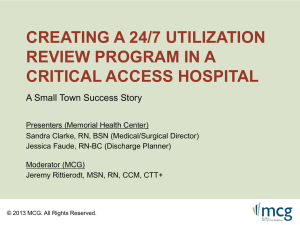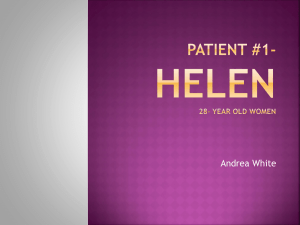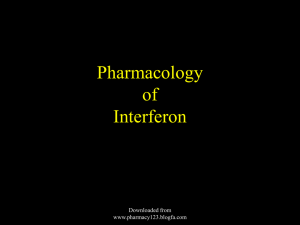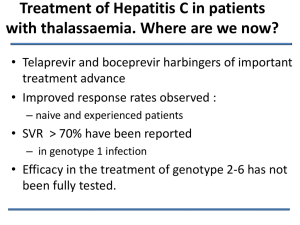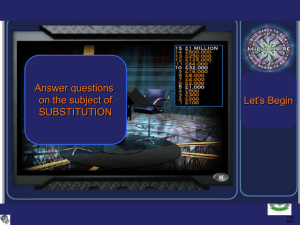Treatment Options Today and in the Future
advertisement
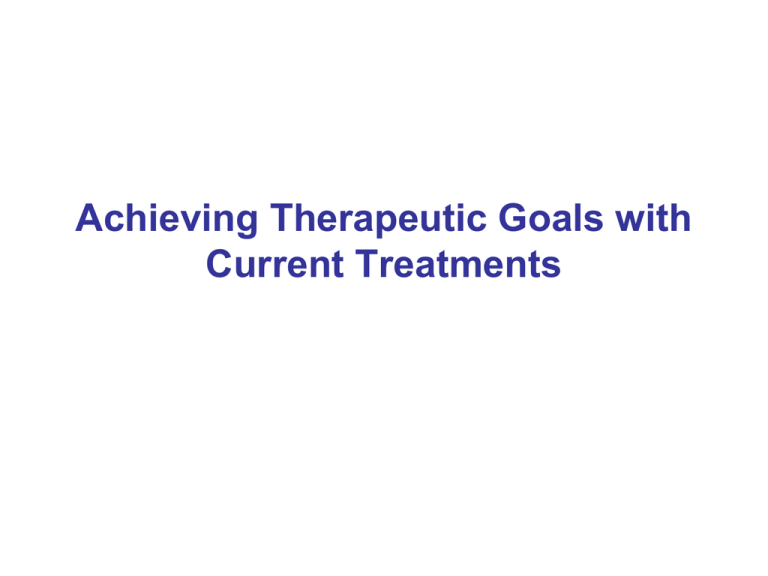
Achieving Therapeutic Goals with Current Treatments ARS Polling Which of the following is not recommended as a first-line treatment for a patient with relapsing-remitting MS? a) Interferon beta-1b 250 mcg SC QOD b) Natalizumab 300 mg IV monthly infusion c) Glatiramer acetate 20 mg SC QD d) Interferon beta-1a 44 mcg SC TIW or 30 mcg IM weekly Therapeutic Goals in MS • In the absence of a cure for MS, current goals of disease modifying therapy are to – Prevent disability – Prevent relapses – Prevent development of new or enhancing lesions on MRI • Additional goals in the management of MS are to – Relieve symptoms – Maintain well-being – Optimize quality of life Treating Acute Relapse • IV corticosteroids = standard of care – Methylprednisolone 500 to 1000 mg/d IV for 3 to 5 days • May be followed by oral steroid taper • High-dose oral steroids may be acceptable alternative – Phase III randomized OMEGA trial currently comparing oral and IV steroids • Plasmapheresis and IVIG for refractory relapse Therapeutic Targets in MS FDA-Approved Disease-Modifying Agents First line: • Interferon beta – Interferon beta-1b 250 mcg SC QOD (two brands) – Interferon beta-1a 44 mcg SC TIW – Interferon beta-1a 30 mcg IM weekly • Glatiramer acetate – 20 mg SC QD Second line: • Mitoxantrone – 12 mg/m2 over 5 to 15 min q3mo; lifetime max, 144 mg/m2 • Natalizumab – 300 mg IV monthly infusion Current First-Line MS Therapies • Interferon beta-1a, interferon beta-1b, glatiramer acetate – Interferons are FDA approved for relapsing forms of MS – Glatiramer acetate is FDA approved for RRMS • Similar efficacy for relapse rate reduction ~ 30% • Generally very safe and well tolerated • All require self-injection Mechanisms of Action for Interferons • Reduction of proinflammatory cytokine secretion • Promotion of anti-inflammatory cytokine secretion • Stabilization of blood-brain barrier • Enhancement of regulatory T cell activity • Downregulation of antigen presentation to T cells Mechanisms of Action for Glatiramer Acetate • Competitive inhibition of antigen presentation (myelin basic protein) to autoreactive T cells • Activates regulatory T cells • Promotes Th1 to Th2 cytokine shift Head-to-Head Study EVIDENCE (IFN beta-1a) Trial, 48 Weeks Patients Relapse-Free IFN beta-1a 30 mcg IM QW IFN beta-1a 44 mcg SC TIW Difference P Value 19% in favor of IFN beta-1a 44 mcg SC TIW <.009 52% 62% Abbreviations: IFN, interferon; IM, intramuscular; QW, once weekly; SC, subcutaneously; TIW, 3 times per week. Pantich H, et al. Neurology. 2002;59:1496-1506. Head-to-Head Study INCOMIN (IFN beta-1b vs beta-1a) Trial, 104 Weeks Patients Relapse-Free IFN beta-1b 250 mcg SC EOD IFN beta-1a 30 mcg IM QW Difference P Value 42% in favor of IFN beta-1b <.036 51% 36% Abbreviations: EOD, every other day; IFN, interferon; IM, intramuscular; QW, once weekly; SC, subcutaneously. Durelli L, et al. Lancet. 2002;359:1453-1460. Head-to-Head Study REGARD (Glatiramer Acetate vs IFN beta-1a), 96 weeks Patients Relapse-Free Glatiramer acetate 20 mg QD 62% IFN beta-1a 44 mcg SC TIW 62% Difference P Value No difference <.96 Abbreviations: IFN, interferon; SC, subcutaneously; QD, once daily; TIW, 3 times per week. Mikol DD, et al. Lancet Neurol. 2008;7:903-914. Head-to-Head Studies BECOME and BEYOND (Glatiramer Acetate vs IFNDifference beta-1b)P Value Patients RelapseFree BECOME1 (18 mo) GA 20 mg QD 70% IFN beta-1b 250 mcg SC QOD 62% BEYOND2 (2 years) GA 20 mg QD 59% IFN beta-1b 250 mcg SC QOD 58% IFN beta-1b 500 mcg SC QOD 60% 8% in favor of GA NS 1% in favor of IFN 500 mcg NS Abbreviations: GA, glatiramer acetate; QD, once daily; IFN, interferon; SC, subcutaneously; QOD, every other day; NS, not significant. 1. Cadavid D, et al. Neurology. 2009;72:1976-1983. 2. O’Connor P, et al. Lancet Neurol. 2009;8:889-897. Head-to-Head Studies Bottom Line • Higher-dose subcutaneous interferons are more effective than lower-dose intramuscular interferon • High-dose subcutaneous interferon formulations and glatiramer acetate probably all offer comparable efficacy Side Effects of Interferons • Side effects include flu-like symptoms, injection site reactions/necrosis (SC), liver enzyme elevations, lymphopenia, depression • Pregnancy category C • Warnings: depression/suicide, decreased peripheral blood counts, hepatic injury, seizures, cardiomyopathy/CHF, autoimmune disease • Laboratory tests: periodic CBC with differential, liver function profile, thyroid function Avonex [package insert]. Cambridge, MA: Biogen Idec; 2006. Betaseron [package insert] Montville, NJ: Bayer HealthCare Pharmaceuticals; 2009. Extavia [package insert]. Montville, NJ: Bayer HealthCare Pharmaceuticals; 2009. Rebif [package insert]. Rockland, MA: EMD Serono; 2009. • Interferon therapies are associated with production of neutralizing antibodies (NAbs) to the interferon beta molecule1 – NAbs may reduce radiographic and clinical effectiveness of interferon treatment • NAb testing – Sometimes used when deciding whether to switch from one interferon to another (usually IM to SC) in a patient with suboptimal response – There are no guidelines on when to test, which test to use, how many tests are needed, or which cutoff titer to apply1 1. Goodin DS, et al. Neurology. 2007;68:977-984. Probability of NAbs (%) Neutralizing Antibodies 100 80 60 40 20 0 45 31 24 5 IFN beta-1b 250 mcg SC QOD IFN beta-1a 22 mcg SC TIW IFN beta-1a 44 mcg SC TIW IFN beta-1a 30 mcg IM QW Data from prescribing information. Side Effects of Glatiramer Acetate • Injection-site reactions, vasodilation, rash, dyspnea, chest pain • Pregnancy category B • Warnings: Immediate postinjection reaction, chest pain, lipoatrophy, skin necrosis – Postinjection reaction (flushing, chest pain, palpitations, anxiety, dyspnea, constriction of throat, urticaria) is self-limited; no treatment required • No lab testing required Copaxone [package insert]. Kansas City, MO: Teva Neuroscience; 2009. Side Effect Management Tips Side Effect Management Flu-like symptoms NSAIDs (eg, naproxen 500 mg 1 h before injection + 12 h later); IFN administration before bedtime; for patients on IFN beta-1a IM, prednisone 10 mg on day of injection; switch to glatiramer acetate Injection-site reactions and injection-site pain Rotate injection sites; administer injection without the autoinjector; topical anesthetics; application of ice before injecting; ensure proper product preparation including warming to room temperature Difficulty selfinjecting Have partner administer injection; if “click” of autoinjector induces anxiety, administer without the autoinjector; call company nurse for retraining; home health agency might administer IFN beta-1a IM; switch to a therapy with less frequent injections Timing of Therapy May Be Key to Preventing Disability First Pre- Demyelinating Relapsing-Remitting Event clinical Transitional Secondary Progressive First Clinical Attack Time window for early treatment Axonal loss Clinical threshold Demyelination Inflammation Time (years) Rationale for Early Treatment • Time is ticking… • What is lost by delaying early therapy is not regained by starting later Treating CIS • Treating CIS vs waiting until patient has clinically definite MS (CDMS) – – – – – Decrease progression to CDMS Decrease rate of disability progression Reduced lesion load on MRI Fewer and less severe relapses Most clinicians advocate early treatment BUT not all CIS will develop MS Placebo-Controlled Trials of Disease-Modifying Therapy in CIS Study Treatment N Conversion to CDMS Followup On Tx Placebo P CHAMPS1 Interferon beta-1a 30 μg IM qwk 383 3y 35% 50% .002 ETOMS2 Interferon beta-1a 22 μg SC once weekly 309 2y 34% 45% .047 BENEFIT3 Interferon beta-1b 250 μg SC q48h 468 2y 28% 45% <.0001 PreCISe4 Glatiramer acetate 20 mg/d 481 3y 61% 77% .0005 1. Jacobs LD, et al. N Engl J Med. 2000;343:898-904. 2. Comi G, et al. Lancet. 2001;357:1576-1582. 3. Kappos L, et al. Neurology. 2006;67:1242-1249. 4. Comi G, et al. Lancet. 2009;374:1503-1511. FDA Approved for CIS • • • • Interferon beta-1a 30 mcg IM QW Interferon beta-1b 250 mcg SC QOD Glatiramer acetate 20 mg SC daily Interferon beta-1a 44 mcg SC TIW is sometimes used off-label Second-Line MS Therapies Natalizumab • Inhibits cell adhesion and leukocyte migration across BBB • AFFIRM trial1 of natalizumab vs placebo in RRMS – 42% reduction in risk of sustained progression of disability in 2 years (P <.001) – 68% reduction in clinical relapse at 1 year (P <.001) – 83% reduction in new or enlarging T2 lesions over 2 years (P <.001) – 92% reduction in Gd-enhancing lesions at 1 and 2 years (P <.001) 1. Polman CH, et al. N Engl J Med. 2006;354:899-910. Second-Line Therapies Natalizumab • FDA approved for relapsing MS • Due to risk of PML, natalizumab is generally reserved for patients who have not responded to or tolerated alternate therapies – PML (JC virus of brain) leads to severe disability or death; no known treatment – Available only through very restricted distribution program (TOUCH Prescribing Program) • Other warnings: hepatotoxicity, hypersensitivity reactions, immunosuppression Tysabri [package insert]. Cambridge, MA: Biogen Idec; 2009. Mitoxantrone • Antineoplastic in anthracenedione class • FDA approved for SPMS, PRMS, worsening RRMS • Causes cross-links and strand breaks in DNA; inhibits B cell, T cell, and macrophage proliferation • Due to serious side effects, reserve for patients with rapidly advancing MS despite other diseasemodifying therapies – – – – Cardiomyopathy (LVEF elevations in up to 18%; CHF) Secondary acute myelogenous leukemia (0.25%) Elevated liver enzyme and glucose levels Requires frequent monitoring (CBC, liver function tests, LVEF, ECG) • Administration should be performed by an oncologist Novantrone [package insert]. Rockland, MA: EMD Serono, and Melville, NY: OSI Pharmaceuticals; 2009. Starting an MS Patient on a Disease-Modifying Agent • Obtain starter kit from local representative – If you do not know your local representative, phone the company’s 800 number • Complete physician portion of Enrollment Form and have patient complete the patient portion – Fax form back to manufacturer • Starter kit will contain educational materials and tools for patient • Company will verify patient’s insurance benefits • Company will supply medication and send nurse to the patient’s home for training on self-injection and proper needle disposal – The nurse may be an added resource for patients to call with questions about the product or self-injection • Titrate interferon dose as indicated on the Enrollment Form Monitoring • Follow up 4−6 weeks after initiating therapy – Assess injection technique and tolerability • If stable on therapy, re-evaluate every 3−6 months • Laboratory testing for interferon – CBC and liver enzyme levels 4–6 weeks after starting treatment, 3 months later, then every 6 months • No laboratory testing needed for glatiramer acetate • Continue on therapy indefinitely unless clear lack of benefit, intolerable side effects, or better treatment becomes available Assess Adherence! Most Patients Who Discontinue Do So in First 2 Years Cohort of patients who stopped therapy Ye ar 7 Ye ar 8 3% Ye ar 6 3% 5% Ye ar 1 22% Ye ar 5 8% Ye ar 4 13% Ye ar 2 27% Ye ar 3 20% Rio J, et al. Mult Scler. 2005;11:306-309. Assess Adherence by Asking • Patients typically will not tell you they have been nonadherent if you do not ask • Ask in nonjudgmental manner that assumes they have missed some doses – For example: How many injections do you think you have missed in the past 2 months? • Being asked helps motivate patients to adhere • Assess barriers by asking: What prevents you from taking your medication? – NOT: Why aren’t you taking it? (Avoid casting blame) Address Barriers to Adherence • • • • • • • • • • Difficulty self injecting Adverse events Unrealistic expectations of therapy (symptom relief) Lack of acceptance of MS diagnosis and need for treatment Financial considerations “Treatment fatigue” Depression Cognitive deficits Impairment in fine motor skills Changes to family and support circumstances Suboptimal Treatment Response • Worsening clinical status • Radiologic changes (MRI) – New Gd enhancement and/or new or enlarging T2 lesions are signs of disease activity • No consensus as to when such findings warrant change in treatment • Interpret in context of whole clinical picture • If found on repeat scans, even if patient is clinically stable, probably warrants change in therapy – Remember: comparison of serial MRI scans requires consistent use of standardized MRI protocol (CMSC protocol) Suboptimal Response Potential Causes • Nonadherence • Pharmacogenomics: responsiveness to IFN β related to genetics1 • Variable pathologies with differing responses to immune therapies • NAbs • MS subtype (disease modifying agents do not work in PPMS) 1. Byun E, et al. Arch Neurol. 2008;65:337-344. Refer or Consult a Neurologist • When diagnosis is in doubt • If a consult is desired regarding selection of initial therapy • For patients with poor response or toleration of first-line therapies • When considering use of natalizumab or mitoxantrone Resources MS Centers in Oregon OHSU Multiple Sclerosis Center 3181 SW Sam Jackson Park Rd, Portland, OR 97239 503-494-7321 Providence Multiple Sclerosis Center 9427 SW Barnes Rd, Suite 595, Portland, OR 97225 503-216-1060 VA Medical Center–Portland 3710 SW US Veterans Hospital Rd (153), Portland, OR 97239 503-220-8262 x 57260 Resources MS Centers in Washington State Cascadia Multiple Sclerosis Center 11 Bellwether Way, Suite 210, Bellingham, WA 98225 360-752-9919 Evergreen Neuroscience Institute MS Center 12040 NE 128th St, MS #118, Kirkland, WA 98034 425-899-5350 Rockwood Multiple Sclerosis Center 400 East Fifth Ave, Spokane, WA 99202 509-838-2531 Swedish Neuroscience Institute 550 17th Ave, Suite 540, Seattle, WA 98122 206-386-3880 Resources MS Centers in Washington State VA MS Center of Excellence–West (VAMC Seattle) 1660 S Columbian Way, Seattle, WA 98108 206-277-4688 Virginia Mason Multiple Sclerosis Center 1100 9th Ave, Seattle, WA 98101 206-223-6600 Western MS Center at University of Washington Medical Center/MSRRTC 1959 NE Pacific St, Seattle, WA 98195 206-598-3344 Resources MS Center in Idaho Idaho Falls Multiple Sclerosis Center 2353 Coronado, Idaho Falls, ID 83404 208-552-4823 Stephen G. Vincent, MD, and Bradford L. Talcott, MD, PhD ARS Polling Which of the following is not recommended as a first-line treatment for a patient with relapsingremitting MS? a) Interferon beta-1b 250 mcg SC QOD b) Natalizumab 300 mg IV monthly infusion c) Glatiramer acetate 20 mg SC QD d) Interferon beta-1a 44 mcg SC TIW or 30 mcg IM weekly Conclusions • Current MS therapies can reduce relapse rates and disability progression – Interferon beta or glatiramer acetate is first line • It is best to start treatment as early as possible • Patient education is essential when starting treatment – Rationale for treatment, injection technique, side effect management, importance of adherence • After starting treatment, monitor for response, tolerability, and adherence
